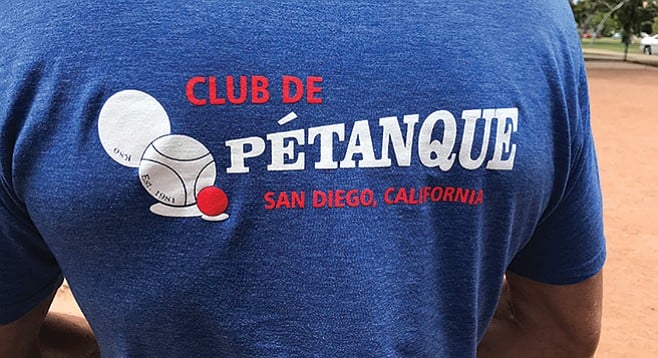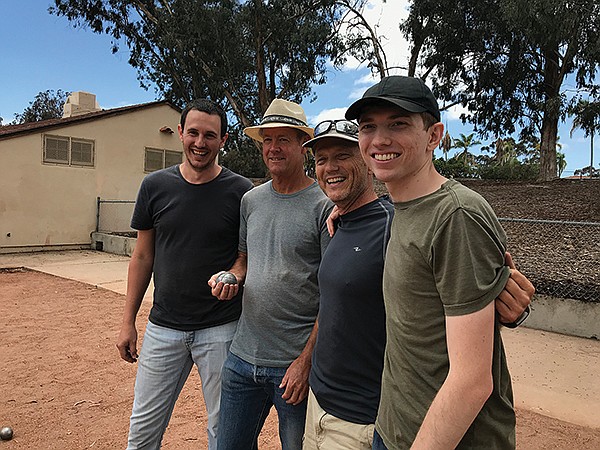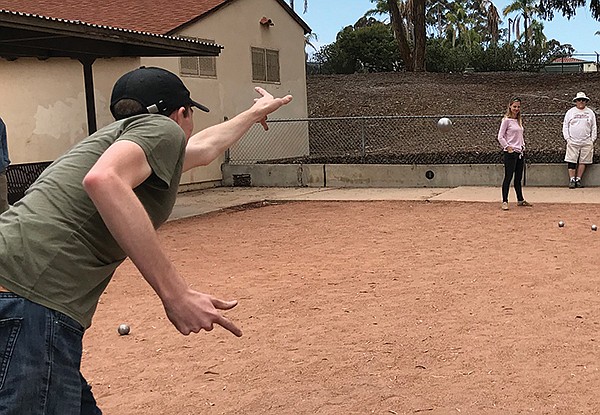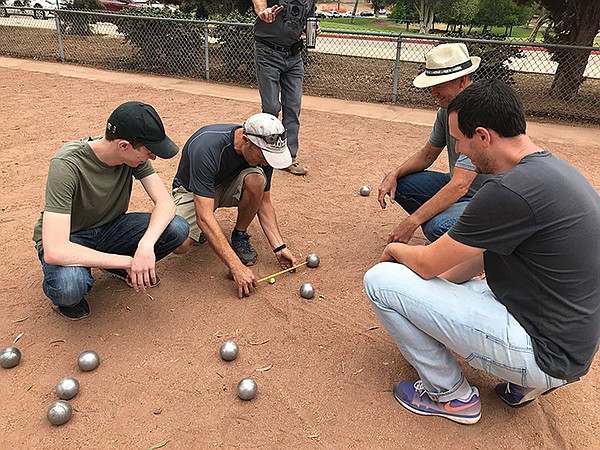 Facebook
Facebook
 X
X
 Instagram
Instagram
 TikTok
TikTok
 Youtube
Youtube

This is Chris Conway’s first day. He’s been meaning to come do this with his dad Gareth for years. But now here he is, in a game he’s never played, French bowls — boules, if you prefer the French spelling — competing against two of the best.

That’s Troy and Vincent. Vincent’s a recent arrival from Paris. He’s good.
“The secret,” says Glenn Schmoll, an older gent who’s a member of the “Noyo Yoyos,” a French bowls club in Noyo, near Fort Bragg, “is to get your first ball in front of the jack. That way if the other side hits it with their first shot, they might just push it closer.”
We’re up in Balboa Park’s northeast corner, near the tennis courts and swimming pool. It’s Sunday morning, and about a dozen members of the Club de Pétanque San Diego have turned up for friendly matches.

This is not your stiff, English, manicured-lawn bowling, played in white flannel pants on the other side of the park. And not even Italian bocce, where you’re confined to a measured, board-lined pit, and you roll, not toss, the bowls.
French bowls, known as pétanque, can be wild.
“It’s very open,” says John Bennett, who’s been playing for six years here. “It’s more social than intensely competitive.”
Today, anyway, they don’t even worry about who’s on your team. To begin, all eight players in the two upcoming contests lob their balls in the air at the same time, towards the jack. Where your bowl lands dictates who you team up with.

Vincent’s here with his wife, Annaelle. They have been in San Diego only a month, but already tracked down this Club de Pétanque. It meets first and third Sundays from 10 to 3 up here at 2229 Morley Field Drive. Anybody can just turn up, borrow bowls, and they promise a “quick start” lesson to get you going.
Vincent has been playing ten years. He’s a great shooter. I watch him standing inside a red plastic circle, lobbing balls, bombing the other side’s best shots away from the jack.
Turns out I’m watching one of the oldest games around. People have been playing this since ancient Rome and earlier, in Egypt and Greece, using solid stone or wooden balls. It was the Roman soldiers who took boules to Gaul — France — and it never left.
It’s just before lunch. Chris, on this first day he’s ever played, has made an unexpectedly strong partner for his dad. (Gareth has been playing 15 years.) Now, they and Vincent and Troy are locked at 12 points each. The aim of the game is to be first to 13. It’s down to Chris to blast away two enemy bowls, or we’re talking curtains for Team Conway. “Make it land here,” says Gareth. He’s pointing towards the jack. “That way you might hit them both away.”
Everybody holds their breath. Chris takes two shots. First scatters to the right. Second bounces to the left.
“Mais oui!” calls Vincent, and he hugs Troy. They’ve won. “And now, lunch!” He turns to me. “Here’s where you’ll see the main difference in the game, as it’s played here and as it’s played in France. Here? Park rules: No wine!”


This is Chris Conway’s first day. He’s been meaning to come do this with his dad Gareth for years. But now here he is, in a game he’s never played, French bowls — boules, if you prefer the French spelling — competing against two of the best.

That’s Troy and Vincent. Vincent’s a recent arrival from Paris. He’s good.
“The secret,” says Glenn Schmoll, an older gent who’s a member of the “Noyo Yoyos,” a French bowls club in Noyo, near Fort Bragg, “is to get your first ball in front of the jack. That way if the other side hits it with their first shot, they might just push it closer.”
We’re up in Balboa Park’s northeast corner, near the tennis courts and swimming pool. It’s Sunday morning, and about a dozen members of the Club de Pétanque San Diego have turned up for friendly matches.

This is not your stiff, English, manicured-lawn bowling, played in white flannel pants on the other side of the park. And not even Italian bocce, where you’re confined to a measured, board-lined pit, and you roll, not toss, the bowls.
French bowls, known as pétanque, can be wild.
“It’s very open,” says John Bennett, who’s been playing for six years here. “It’s more social than intensely competitive.”
Today, anyway, they don’t even worry about who’s on your team. To begin, all eight players in the two upcoming contests lob their balls in the air at the same time, towards the jack. Where your bowl lands dictates who you team up with.

Vincent’s here with his wife, Annaelle. They have been in San Diego only a month, but already tracked down this Club de Pétanque. It meets first and third Sundays from 10 to 3 up here at 2229 Morley Field Drive. Anybody can just turn up, borrow bowls, and they promise a “quick start” lesson to get you going.
Vincent has been playing ten years. He’s a great shooter. I watch him standing inside a red plastic circle, lobbing balls, bombing the other side’s best shots away from the jack.
Turns out I’m watching one of the oldest games around. People have been playing this since ancient Rome and earlier, in Egypt and Greece, using solid stone or wooden balls. It was the Roman soldiers who took boules to Gaul — France — and it never left.
It’s just before lunch. Chris, on this first day he’s ever played, has made an unexpectedly strong partner for his dad. (Gareth has been playing 15 years.) Now, they and Vincent and Troy are locked at 12 points each. The aim of the game is to be first to 13. It’s down to Chris to blast away two enemy bowls, or we’re talking curtains for Team Conway. “Make it land here,” says Gareth. He’s pointing towards the jack. “That way you might hit them both away.”
Everybody holds their breath. Chris takes two shots. First scatters to the right. Second bounces to the left.
“Mais oui!” calls Vincent, and he hugs Troy. They’ve won. “And now, lunch!” He turns to me. “Here’s where you’ll see the main difference in the game, as it’s played here and as it’s played in France. Here? Park rules: No wine!”
Comments